Environment
A bold new era of low-carbon shipping

photo: UNSPLASH
With the onset of new and stricter regulations for limiting carbon emissions of maritime vessels, the shipping companies are preparing for low-carbon seafaring. Meanwhile, new and innovative technologies for reducing CO2 greenhouse gas emissions of ships are being constantly developed.
Oa global scale, ship emissions add
up to approximately three percent
of CO2 greenhouse gases released to the
atmosphere.
”Recently, new regulations and
requirements have been drafted with
regard to greenhouse gas emissions of
maritime vessels,” notes Mr. Olli Kaljala,
Marine Chief Executive for Finland and
Baltic
States at Bureau Veritas.
”For one thing, European Union has
published the MRV (Monitoring, Reporting
and Verification) Regulation. Furthermore,
International Maritime Organisation
IMO has drawn up new goals for reducing
CO2 emission levels for ships.”
STRICTER RULES WILL FOLLOW
The EU Commission’s meaning was to
create MRV to enable data collection and
reporting of maritime emission data. The
MRV regulation has been enforced since
2018.
”Data on ship emissions is to be
reported annually and archived,” specifies
Kaljala.
The specific dates for annual reporting
are coordinated. Once a year, a heap
of reports arrives at the offices of Bureau
Veritas and other classification bureaus for
perusal and recording.
As things stand, the MRV regulation
does not yet define the maximum level
of CO2 emission that is allowed for the
ships. However, CO2 emissions are juxtaposed
with the amounts of transported
goods, with the goal of improving the efficiency
of maritime transports.
”Stricter regulations for emissions are
to be expected in the near future. At that
stage, vessels will be required to operate
within permitted emission levels,” Kaljala
says.
The data collected in accordance
with MRV regulations can be helpful when
practical applications for reducing maritime
greenhouse gas emissions are contemplated.
The MRV regulation affects all maritime
traffic to and from EU ports, regardless
of the ship’s flag country.

photo: MSC CRUISES
NEW SOLUTIONS AND TECHNIQUES
To minimise CO2 emissions, ships will
undoubtedly need new fuels and fuel technologies,
as well as exhaust-gas cleaning
devices.
”Additionally, ships may benefit from
hybrid solutions, such as utilisation of wind
turbines as secondary power units. A number
of these types of solutions for low-carbon
maritime traffic are already in use,”
Kaljala points out.
”IMO is set on reducing all maritime
CO2 emissions by at least 50 percent by the
year 2050. This will require a wide range
of different kinds of engineering feats, in
the short and long term.”
According to Mr. Kaljala, new technologies
will be developed as new rules
and regulations for low-carbon shipping
keep emerging.
”Eventually, the best practices and
techologies will become the standard.
Some of them will be incorporated into
future maritime regulations.”
INNOVATIVE R&D AT UNIVERSITY OF VAASA
Various cruise lines have also started implementing
Ship Energy Management Plans
to reduce CO2 emissions and to improve
energy efficiency in seafaring. The plan
aims at reducing carbon emissions by 30
percent by the year 2025.
On the engineering side, new technologies
for low-carbon shipping are constantly
being developed and tested.
A consortium led by the University of
Vaasa – on the west coast of Finland – is
engaged in a project to reduce shipping
emissions by bringing low-carbon energy
forms and various technologies to vessels,
as well as developing the way vessels are
designed and operated. These energy
forms include hydrogen, wind power, electric
batteries, heat-recovery technologies,
plus air lubrication and new anti-fouling
technology.
The consortium is about to receive
significant funding from the EU’s Horizon
2020 programme for this research project
called CHEK, with the stated aim of de-carbonising
shipping by enabling key technology
and innovative ship design.
participants are World Maritime University,
Wärtsilä, Cargill, MSC Cruises,
Lloyds Register, Silverstream Technologies,
Hasytec, Deltamarin, Climeon, and
BAR Technologies.

photo: MSC CRUISES
HIGH-RISING GOALS FOR LOW-CARBON SHIPS
The results of the project will eventually be
field-tested on two vessels. One of them
is the bulk carrier ’Cargill,’ making use of
wind energy by utilising a sail. Another
vessel in the pilot tests is an MSC Cruises
passenger ship to be equipped with a
hydrogen-powered ship engine that will
be designed during the project.
According to researchers, the use
and symbiosis of new innovative technologies
can reduce as much as 99 percent
of greenhouse gas emissions, achieve
energy savings of up to 50 percent, and
also reduce black carbon emissions by
more than 95 percent.
Such innovative technologies will not
simply be stacked onto vessels. The project
will also develop the Future-Proof Vessel
(FPV) Design Platform for charting the
design of future low-carbon and energyefficient
ships.
The new type of ship platform will
provide the means to combine new technologies
as favourably as possible so that
they will be able to work together in the
best possible way.
Text by Ari Mononen



